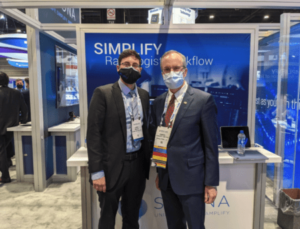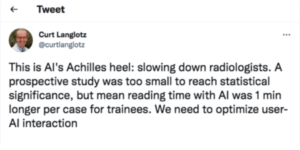RSNA 2021: Hype vs Reality and What Really Matters
After an absence last year, the largest radiological conference in the world took place in person, right after Thanksgiving in surprisingly balmy Chicago. RSNA 2021 was a great opportunity to take some time to showcase what we’ve been working on at Sirona, but it was also a reminder of an industry prone to buzzwords and marketing spin. The messaging from numerous vendors at the conference was all about ‘AI’ and ‘integration’, but most of the product demos I saw failed to live up to the hype. Before building these new applications, how much time did they spend in a reading room with radiologists? I really began to wonder.

AI’s Achilles heel I saw nothing to disprove the wise sentiments of Curt Langlotz just before the conference, when he tweeted an interesting study by Muller et al1

If the biggest advocate for AI in radiology is concerned about how AI is being deployed in clinical practice, you know you have a problem. In fact, in my own practice, we recently voted to remove an AI detection feature because it was so poorly integrated within our workflow and just added to our read times without providing a real clinical benefit. In principle we do not mind being told that ‘an intracranial hemorrhage has been detected’, but when it doesn’t tell us which image or series number this was detected from and doesn’t automatically insert this into the report, we have to spend an inordinate amount of time re-reading to double check the validity of the detection. Even worse: if we don’t do this, the referring physician could see this AI diagnosis and wonder why there was no mention of it in the report, even if we were sure the detection was erroneous. These problems arise when AI is thought of as a new standalone product feature, instead of being part of a unified, cohesive user experience. AI tools should seamlessly integrate into the viewer, on the image, and AI findings should appear in the report without the need for the rad to take their eyes off the image. Implementing AI tools on top of already-broken workflows with legacy systems is not going to do the trick. I saw far too many vendors showcasing exported PDF reports, secondary captures, extra windows… basically another study to interpret on top of the original study. It’s like telling iPhone users that every other picture they take will be stored in separate folders, and you can’t view all your photos in one place. The impact on the radiologist report, which is our business card to the wider healthcare community, was all too often an afterthought.
Explaining Sirona It was my job to explain why things might be different with Sirona. You could see the light bulbs going off in people’s heads once they understood the power of a unified solution that allows for easy navigation between viewer and reporter, keeping everything in sync without the need for the radiologist to double-check constantly. For example, our Anatomic Navigator allows for a user to tab through the various vertebral headers (e.g. L1-2) in the reporter, with the axial slices on the viewer jumping to the appropriate level automatically. This means a radiologist never has to worry about dictating in the wrong level and having to cut and paste to the right level. It also means not having to swivel back and forth just to make sure the cursor is in the right place. Meanwhile, our Image Bookmark feature makes lesion comparison to prior studies only a click away. The point I’m trying to make here is that I was demonstrating a system that actually fits the radiologist, as opposed to forcing the radiologist to fit the system. After the demo, I would ask the rads what new features/enhancements they would like to see in their existing systems. More often than not, the answer was quite simply ‘better workflow’. It was telling that very few even mentioned AI or anything remotely complex – it was all about the workflow. While the marketing speak runs away with itself by emphasizing the supposed intelligence of individual features, all we really want is the peace of mind that the key components of our workday are in sync. If something can help us manage the viewer, reporter and worklist more intuitively, then great! Despite me being a tech aficionado, it’s really beside the point if a software feature is powered by the latest AI algorithms or not. As I’ve pointed out previously, the main challenge with today’s radiology workflow is the administrative burden it forces onto the radiologists, or ‘memory traps’ as I called it. Much of these problems arise from the fragmented software applications we’re forced to use on a daily basis. Once my fellow radiologists saw Sirona’s unified Workspace in action, they were excited by the prospect of previously intractable workflow issues becoming a thing of the past.
Wrapping up If there’s one thing I learnt from the conference, it’s that my last two years of working side by side with engineers to build the RadOS platform have been very much worth it. Numerous product demos made it clear there is a need for a unified platform, and that you can only truly capitalize on the power of AI and machine learning if it is underpinned by a workflow that is bi-directional and intuitive. Now it’s time for me to get back in the lab and optimize that workflow even better for RSNA 2022!
Some of the product ideas and features described in this article are future oriented and may not be reflected in Sirona’s commercial applications.
1 Impact of Concurrent Use of Artificial Intelligence Tools on Radiologists Reading Time: A Prospective Feasibility Study. Felix C. Muller, FM, Henriette Raaschou, HR, Naurien Akhtar, NA, Mathias Brejnebøl, MBr, Lene Collatz, LC, Michael Brun Andersen, MBA MKT020 Rev A.0